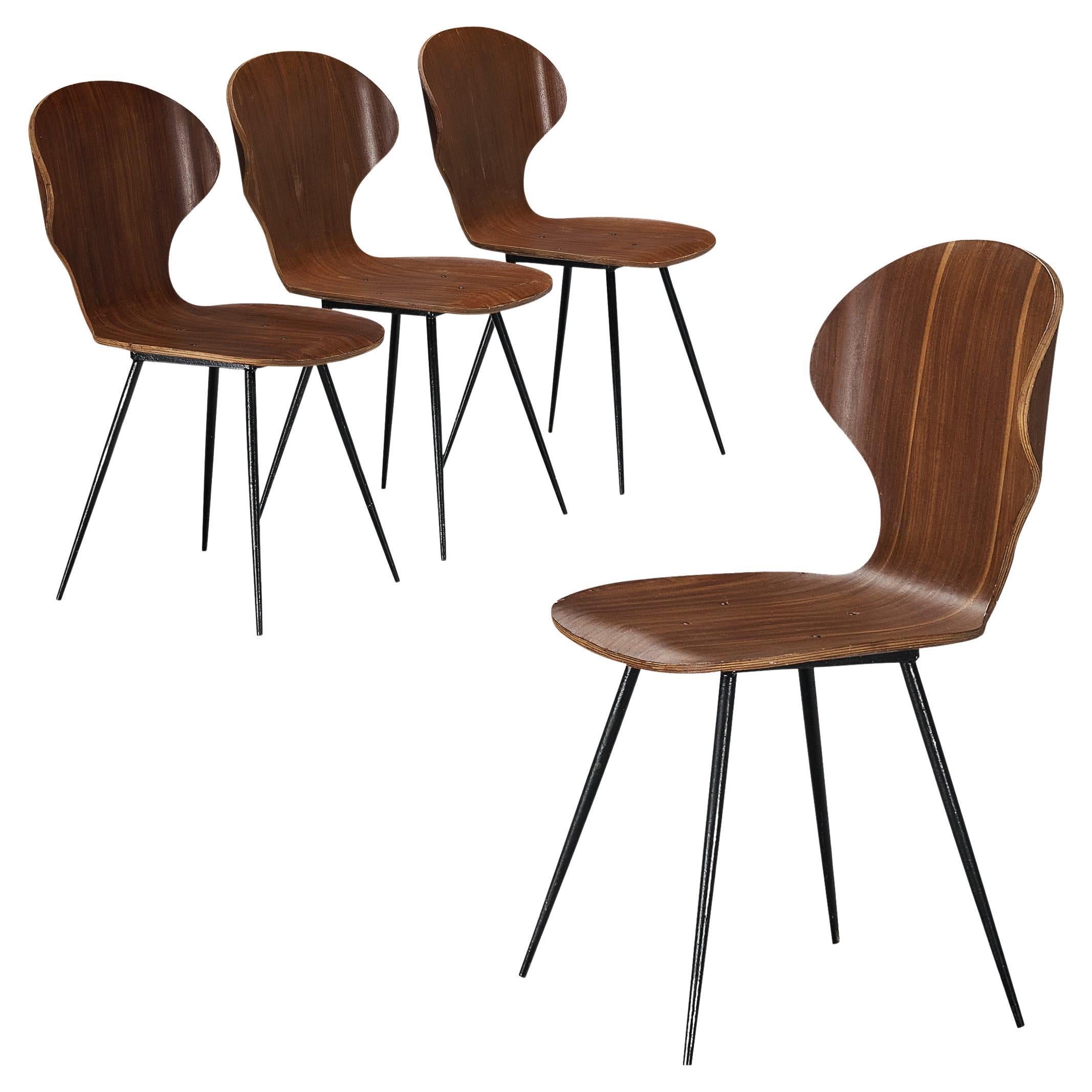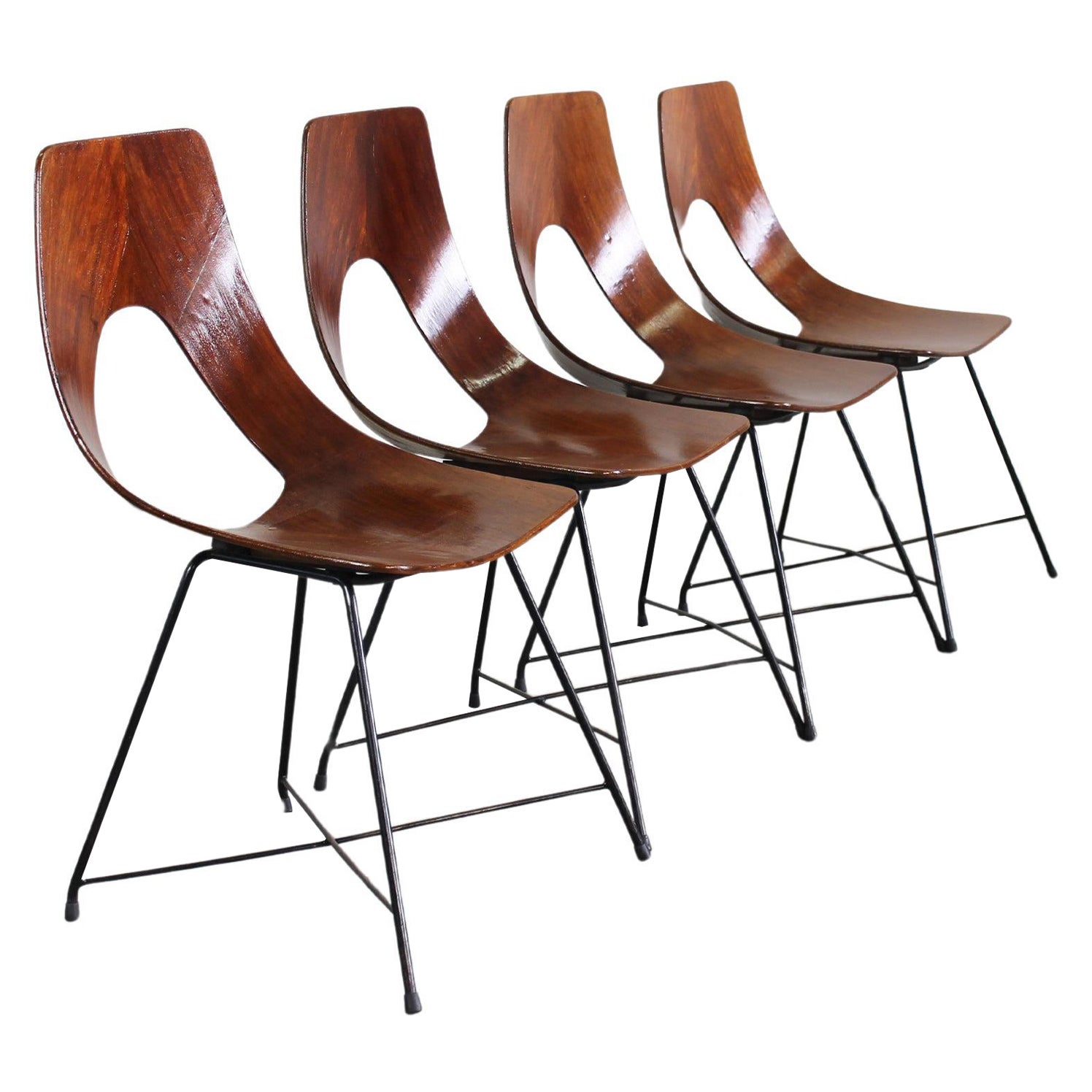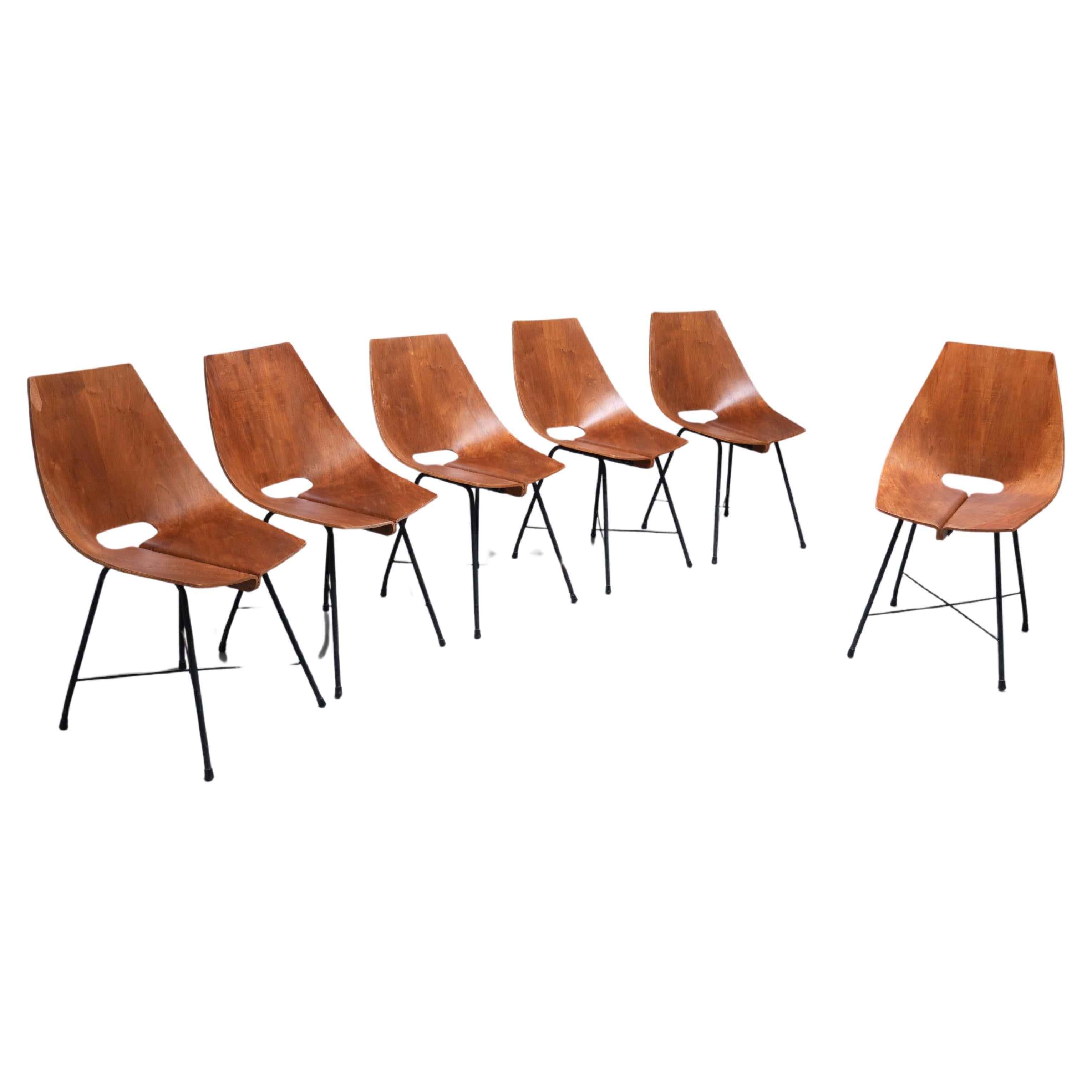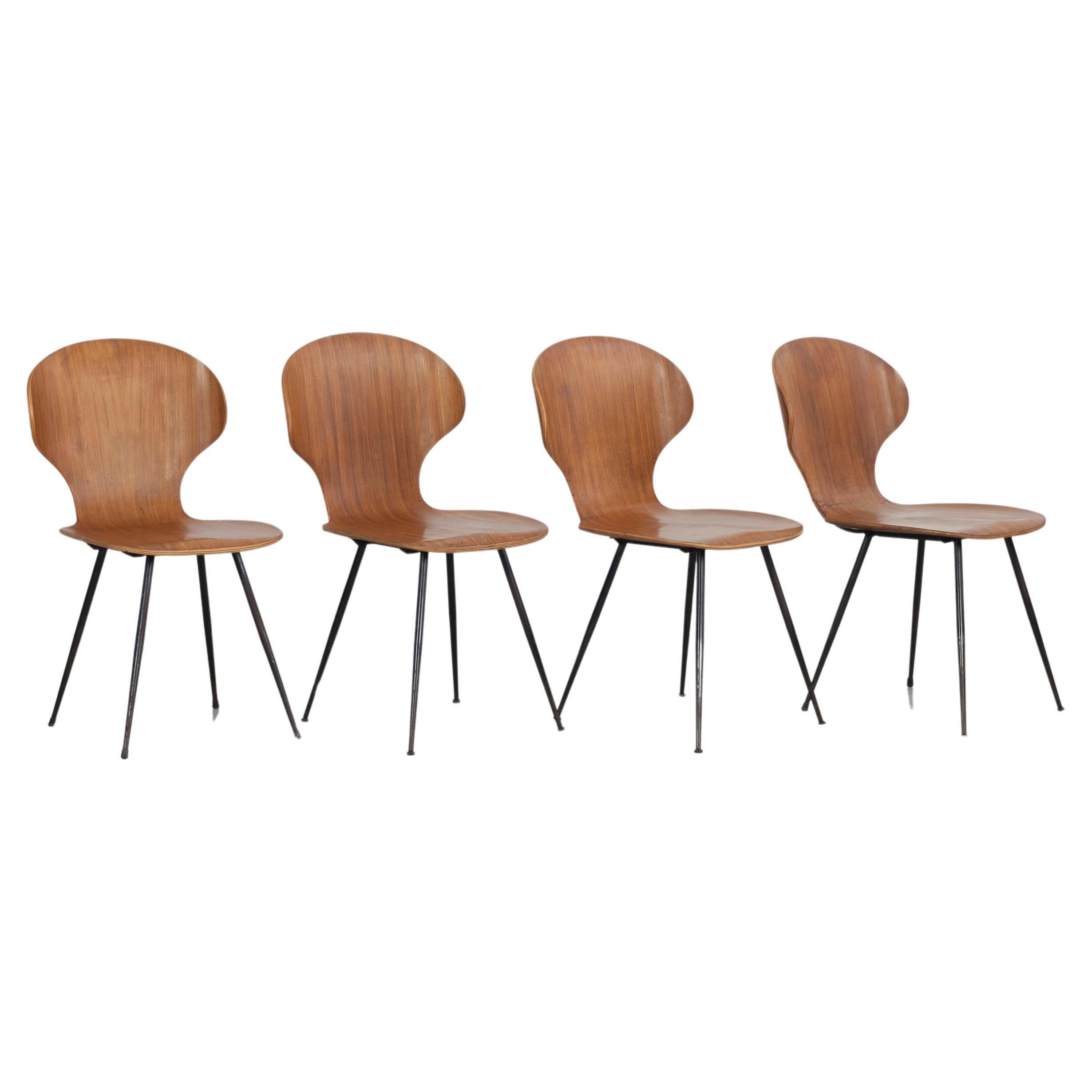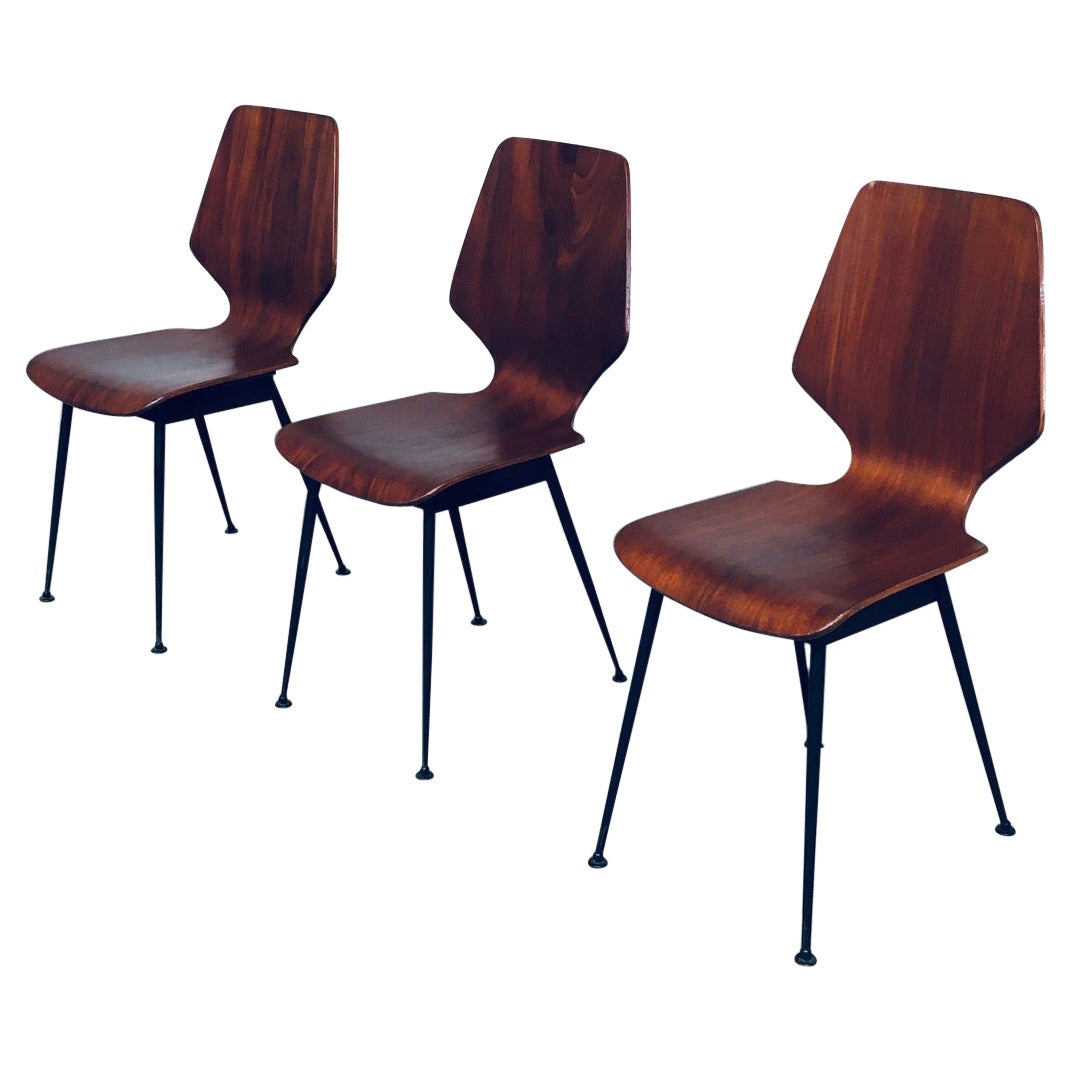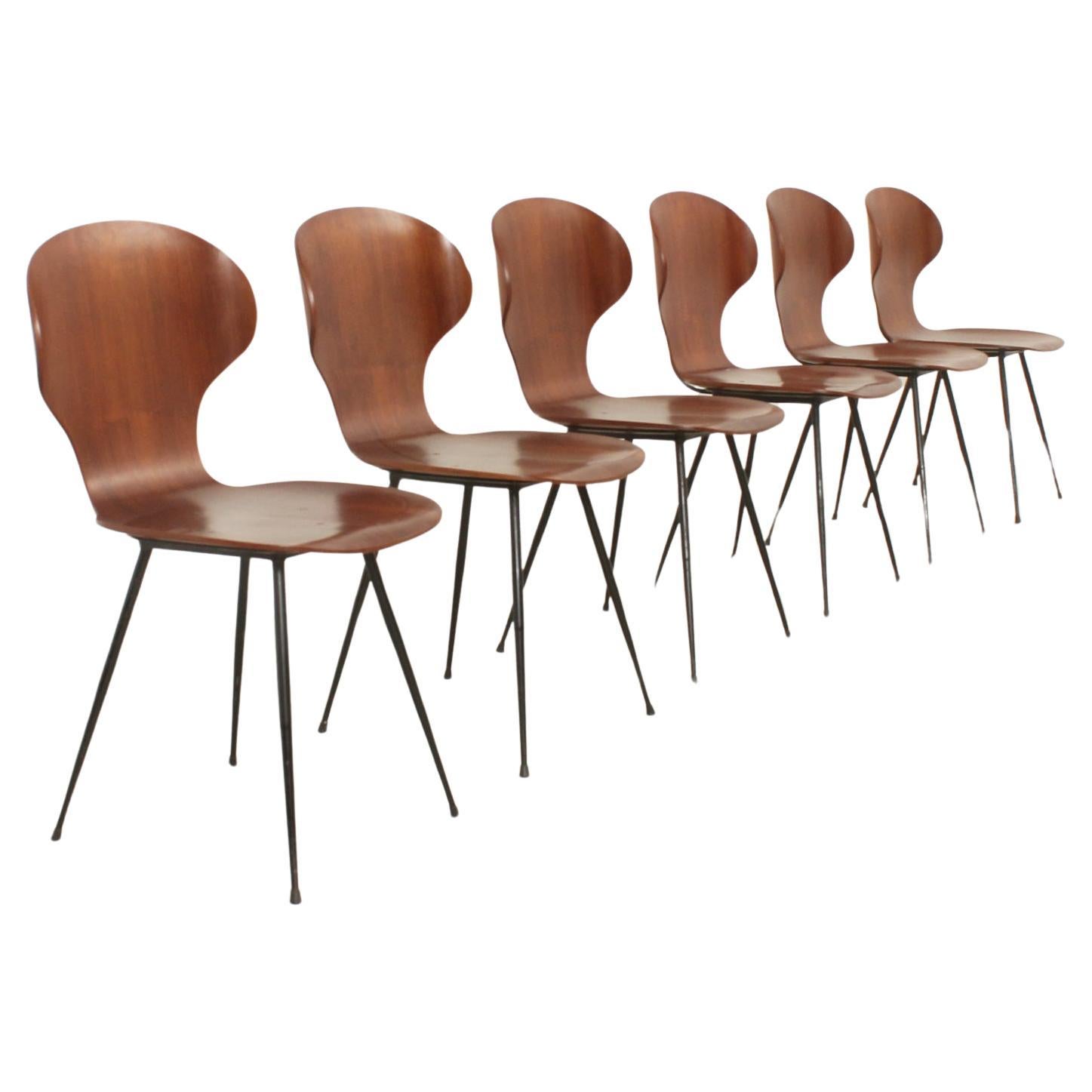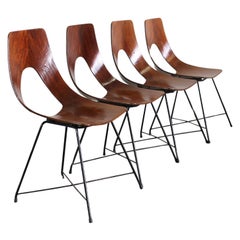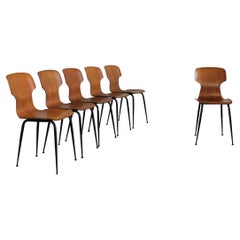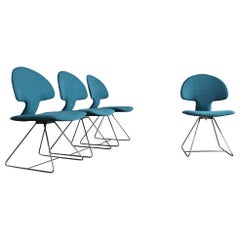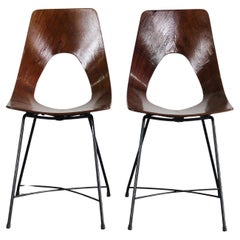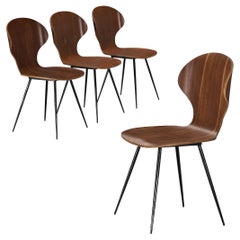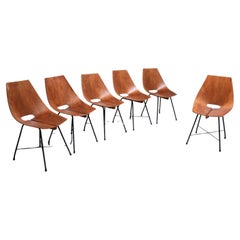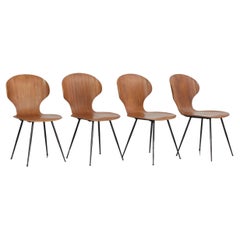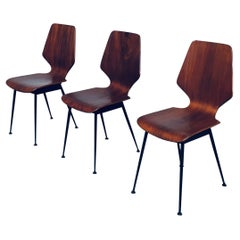Artículos similares a Carlo Ratti Set of Four Chairs in Plywood by Società Compensati Curvi 1950s
¿Quieres más imágenes o vídeos?
Solicita imágenes o vídeos adicionales al vendedor
1 de 9
Carlo Ratti Set of Four Chairs in Plywood by Società Compensati Curvi 1950s
4500 €por juego|IVA incluido
Acerca del artículo
Set of four dining chairs with a frame in black lacquered metal and seat in curved plywood, attributed to Carlo Ratti and produced by Società Compensati Curvati in the 1950s.
In Italy, at the beginning of the XX century, industries of curved solid wood arose under license of Michael Thonet, and through the International Exhibitions the processing of curved wood became more and more widespread.
The Expo of the first decade was also attended by the wood manufacturers of Monza, while in 1905 Otto Helzer, in Switzerland, patented wooden structures in curved laminated, whose strength was equivalent to those in steel.
The Ratti brothers of Monza took their cue from the solid wood laminate to create furniture that, instead of wooden elements, used sheets of wood.
The brothers Ratti, Carlo and Mario, also began to follow the young artistic avant-gardes (cubism, futurism and abstractionism).
The mastery of wooden sculpture influenced Carlo in the design and realization of furniture of fine neo-plastic artistic workmanship and decò, receiving honors from the Prince of Piedmont Umberto di Savoia.
In 1919, in Milan, the first Lombard Exhibition of Decorative Arts was set up (later to become the Triennale) and the Ratti brothers exhibited their furniture in solid wood but also in curved panel with a new system of curvature, the one in Telo.
The canvas system was developed by the Ratti brothers with the help of a friend, Cesare Cantù.
They developed an elastomer bag in which the mould was inserted with the panel to be bent and, closing it with clamps, the air inside was removed, thus making the panel adhere to the mould.
Carlo and Mario found in the Telo system a means by which they could make objects and furniture in the three spatial directions with large surface curvatures, without limits of thickness and minimum radii of curvature.
In 1921 in Stuttgart the first Salone del Mobile was inaugurated and the Fratelli Ratti of Monza made itself known internationally by presenting solid wood furniture and also furniture in load-bearing plywood, flanked by furniture with framed and interchangeable covers.
The Expo became meeting places to verify and present the novelties in the furniture and industrialization sector and, with the development of Industrial Design, the first architects joined in the design of the furniture industries.
The Ratti Brothers, in the various international and national exhibitions, also presented incredible objects in their realization with the system in Telo.
After 1930 Carlo and Mario produced many containers for radio and folding chairs for cinema but in 1939 they divided and in Monza Mario remained who, with his sons Antonio and Angela, formed the Società Compensati Curvi.
Carlo moved to Lissone, forming with his sons Angelo and Piera and with her husband, Piero Berruti, the Industria Legni Curvati. After the war, a new bending system, the Mould and Counter-mould, was added to the existing systems from the 1950s.
After the war, the architects devoted themselves exclusively to the planning and reconstruction of the territory and the need to regain the markets put the industrialists in conditions to offer quality products, designed by architects-designers of the new generation.
Both Carlo Ratti’s and Mario’s firm began collaborating with world-famous architects such as Ignazio Gardella, Paolo Chessa, Vico Magistretti, the Castiglioni brothers, Vittoriano Vigano, Marco Zanuso, Carlo de Carli, etc.
In those years many technological objects were made with curved plywood bodies such as washing machines, televisions, radios, sewing machines, etc. while the production of furniture in a rationalistic style continued.
The new bending technologies, Mould and Counter-mould and High Frequency, allowed a remarkable mass production and, if the old system in Telo continued to exist to make extraordinary objects with Coons curves, especially the High Frequency spread all over the world.
The Japanese company Tendo Mokko invented this new bending system in 1948, trying to make plywood planes and, immediately, the company Ratti of Monza used it, while that of Lissone continued to make products with the old Mould and Counter-mould system.
This system used aluminum shapes unlike other systems that, instead, made wooden shapes, with considerable economic savings.
In 1954 a chair designed by Carlo de Carli for Cassina and made by Carlo Ratti won the "Compasso d'Oro" award as an object of considerable technical and aesthetic value.
In 1961 Carlo Ratti died and his sons Angelo and Piera, with her husband Piero Berruti, continued the activity while the third generation was entering the company.
The company transformed from Industria Legni Curvati into Carlo Ratti s.a.s and, since then, new collaborations with young architects allowed a new technological development.
Thus, the High Frequency system was introduced in the company, but the Mould and Counter-mould system was not abandoned and, above all, the Telo system that was still used for the production of samples and prototypes.
- Creador:Società Compensati Curvati (Fabricante)
- Atribuido a:Carlo Ratti (Diseñador)
- Dimensiones:Altura: 80 cm (31,5 in)Anchura: 50 cm (19,69 in)Profundidad: 45 cm (17,72 in)
- Se vende como:Juego de 4
- Estilo:Moderno de mediados de siglo (Del período)
- Materiales y técnicas:
- Lugar de origen:
- Época:
- Fecha de fabricación:1950s
- Estado:Desgaste acorde con la edad y el uso.
- Ubicación del vendedor:Montecatini Terme, IT
- Número de referencia:1stDibs: LU5304223682922
Sobre el vendedor
4,9
Vendedor Oro
Vendedores premium que mantienen una calificación de +4,3 y tiempos de respuesta de 24 horas
Vendedor de 1stDibs desde 2020
129 ventas en 1stDibs
Tiempo de respuesta usual: 1 hora
- EnvíoRecuperando presupuesto…Envío desde: Florence, Italia
- Política de devolución
Partes de esta página se han traducido automáticamente. 1stDibs no puede garantizar la exactitud de las traducciones. El inglés es el idioma predeterminado de este sitio web.
Garantía de autenticidad
En el improbable caso de que haya algún problema con la autenticidad de un artículo, ponte en contacto con nosotros en un plazo de 1 año para recibir un reembolso total. DetallesGarantía de devolución de dinero
Si tu artículo no es como se describe, sufre daños durante el transporte o no llega, ponte en contacto con nosotros en un plazo de 7 días para recibir un reembolso total. DetallesCancelación dentro de las 24 horas
Tienes un período de gracia de 24 horas para reconsiderar tu compra, sin preguntas.Vendedores profesionales aprobados
Nuestros vendedores de primera clase deben cumplir estrictos estándares de servicio para mantener la integridad de nuestros anuncios.Garantía de igualación de precios
Si encuentras que un vendedor publicó el mismo artículo por un precio menor en otro lado, igualaremos ese precio.Entrega global de confianza
Nuestra red de transporte de primera ofrece opciones de envío especializado en todo el mundo, que incluye envío personalizado.Más de este vendedor
Ver todoAugusto Bozzi Juego de cuatro sillas Ariston de madera contrachapada y metal by Saporiti Años 50
Por Fratelli Saporiti, Augusto Bozzi
Conjunto de cuatro sillas de comedor modelo Ariston con estructura de madera contrachapada curvada y patas de metal lacado en negro.
La silla Ariston fue diseñada por Augusto Bozzi ...
Categoría
Vintage, Década de 1950, Italiano, Moderno de mediados de siglo, Sillas
Materiales
Metal
Carlo Ratti Conjunto de seis sillas de madera contrachapada de Industria Legni Curvati Lissone 1950
Por Industria Legni Curvati, Carlo Ratti
Conjunto de seis sillas de comedor con respaldos y asientos realizados en contrachapado curvado y patas de metal lacado en negro, diseñadas por Carlo Ratti y fabricadas por Industria...
Categoría
Vintage, Década de 1950, Italiano, Moderno de mediados de siglo, Sillas
Materiales
Metal
Vittorio Introini Juego de cuatro sillas de comedor Longobarda de Saporiti Años 60 Italia
Por Saporiti, Vittorio Introini
Juego de cuatro sillas Longobarda con patas de metal cromado, asiento y respaldo tapizados con tela de color azul.
La silla Longobarda fue diseñada por Vittorio Introini y fabricada...
Categoría
Vintage, Década de 1960, Italiano, Moderno de mediados de siglo, Sillas
Materiales
Metal
Augusto Bozzi Conjunto de dos sillas Ariston de madera contrachapada y metal by Saporiti Años 50
Por Saporiti, Augusto Bozzi
Conjunto de dos sillas de comedor modelo Ariston con estructura de madera contrachapada curvada y patas de metal lacado en negro.
La silla Ariston fue diseñada por Augusto Bozzi y f...
Categoría
Vintage, Década de 1950, Italiano, Moderno de mediados de siglo, Sillas
Materiales
Metal
Sineo Gemignani Juego de Seis Sillas de Madera Curvada Fabricación Italiana Década de 1940
Por Sineo Gemignani
Rarísimo juego de seis sillas de comedor totalmente de madera curvada, este conjunto fue diseñado por el artista italiano Sineo Gemignani y fabricado en Italia durante la década de 1...
Categoría
Vintage, Década de 1940, Italiano, Moderno de mediados de siglo, Sillas
Materiales
Madera
Gio Ponti (Atribuido a) Conjunto de cinco sillas de madera y cuero de ISA Bergamo
Por I.S.A. Italy, Gio Ponti
Conjunto de cinco sillas de comedor con estructura de madera, asiento y respaldo de cuero acolchado, producidas por el fabricante italiano ISA Bergamo el diseño de este conjunto se a...
Categoría
Vintage, Década de 1950, Italiano, Moderno de mediados de siglo, Sillas
Materiales
Cuero, Madera
8500 € juego
Envío gratuito
También te puede gustar
Carlo Ratti Juego de cuatro sillas de comedor de madera contrachapada y metal
Por Industria Legni Curvati, Carlo Ratti
Carlo Ratti para Industria Legni Curvati, juego de cuatro sillas de comedor, madera contrachapada con un fino de teca y metal, Italia, años setenta.
Un elegante juego de sillas de c...
Categoría
Vintage, Década de 1970, Italiano, Moderno de mediados de siglo, Sillas ...
Materiales
Metal
Juego de 6 sillas de comedor de Carlo Ratti en contrachapado y metal, Italia, 1954
Por Carlo Ratti, Società Compensati Curvati
Restauramos completamente este conjunto añadiendo nuevas piezas pequeñas de chapa de madera (donde era necesario) a todas las sillas y lacándolas tres veces. Hubo que sustituir más d...
Categoría
Vintage, Década de 1950, Italiano, Moderno de mediados de siglo, Sillas ...
Materiales
Metal
Juego de 4 sillas de madera curvada de Carlo Ratti, Industria Legni Curvati, Italia 1950s.
Por Industria Legni Curvati, Carlo Ratti
Este modelo de silla italiana fue diseñado en la década de 1950 por Carlo Ratti para Industira Legni Curvati Lissoni y está hecho de madera curvada y patas de metal lacadas en negro....
Categoría
Vintage, Década de 1950, Italiano, Moderno de mediados de siglo, Sillas ...
Materiales
Metal
Sillas auxiliares de contrachapado atribuidas a Carlo Ratti para Legni Curvati, Italia Años 50
Por Carlo Ratti
Sillas auxiliares vintage de madera contrachapada de diseño italiano moderno de mediados de siglo atribuidas a Carlo Ratti para Legni Curvati. Fabricado en Italia, época de 1950. Jue...
Categoría
Vintage, Década de 1950, Italiano, Moderno de mediados de siglo, Sillas ...
Materiales
Metal
1920 € Precio de venta juego
Descuento del 20 %
Juego de seis sillas auxiliares de contrachapado de Carlo Ratti, Italia, años 50
Por Carlo Ratti, Industria Legni Curvati
Conjunto de seis sillas diseñadas por Carlo Ratti para Industria Legni Curvati Lissoni, Italia, años cincuenta. Asiento de madera contrachapada y base de metal negro.
Categoría
Vintage, Década de 1960, Italiano, Moderno de mediados de siglo, Sillas ...
Materiales
Metal
Cuatro sillas Medea de Vittorio Nobili, Fratelli Tagliabue, Italia, años 50
Por Vittorio Nobili
Bonito juego de cuatro sillas Medea auténticas de Vittorio Nobili para Fratelli Tagliabue, Italia, años 50. Este conjunto tiene unas raras zapatas de latón que parecen haber sido aña...
Categoría
mediados del siglo XX, Italiano, Moderno de mediados de siglo, Sillas de...
Materiales
Metal
